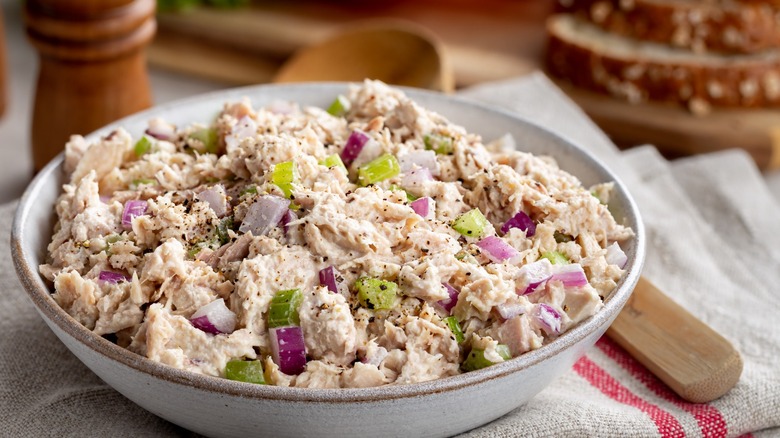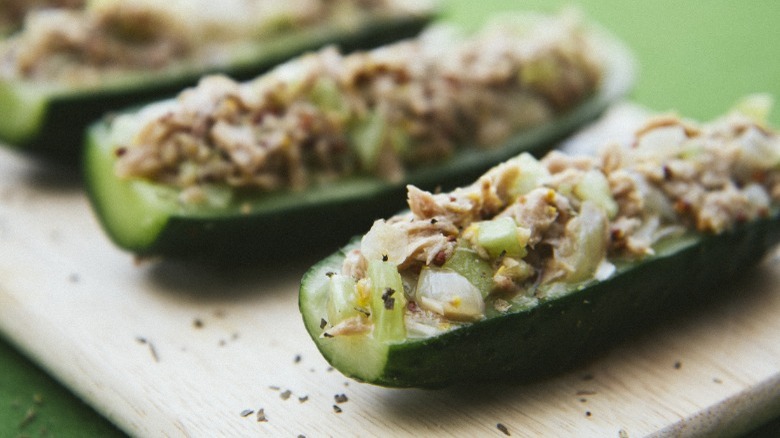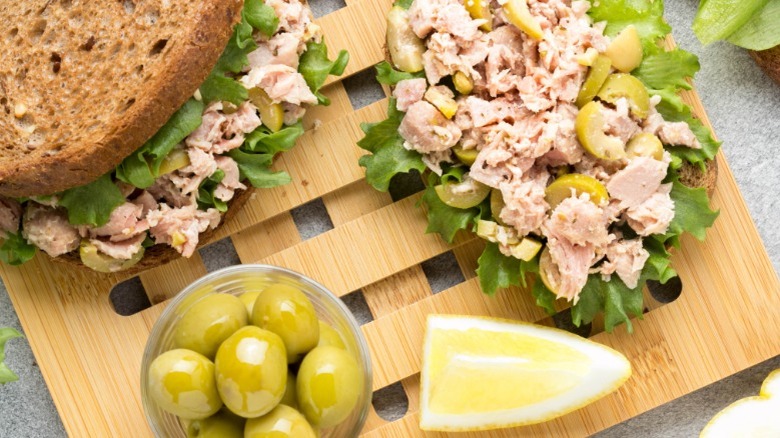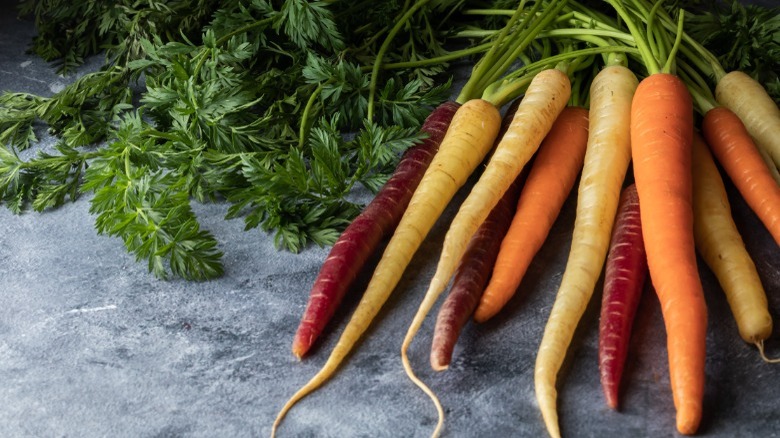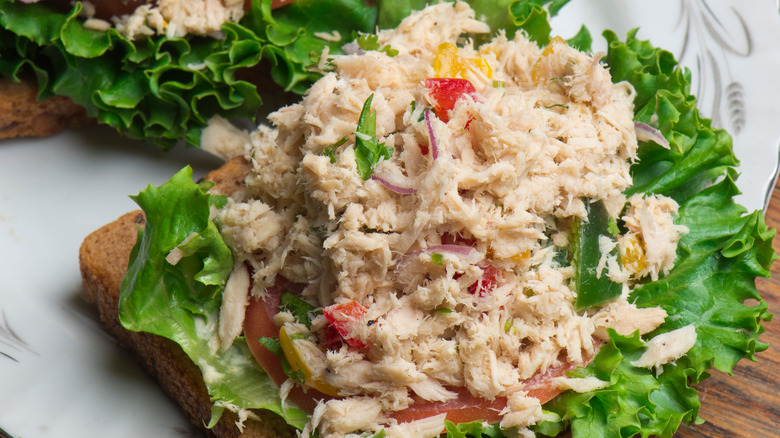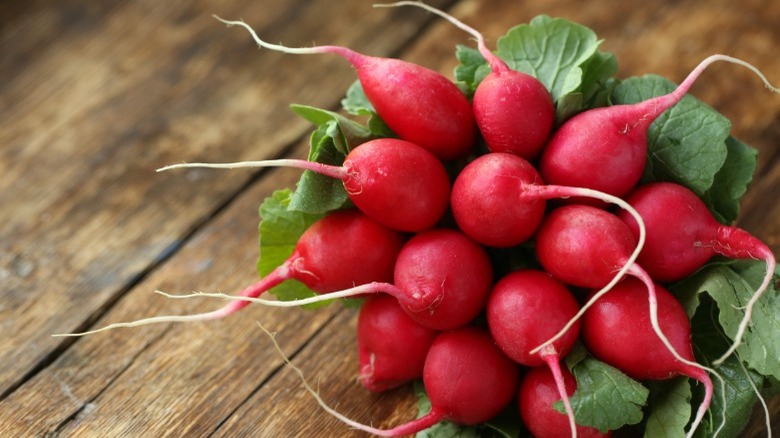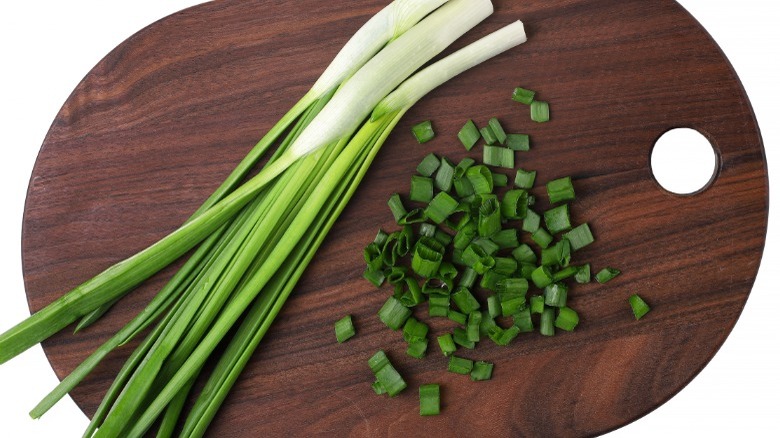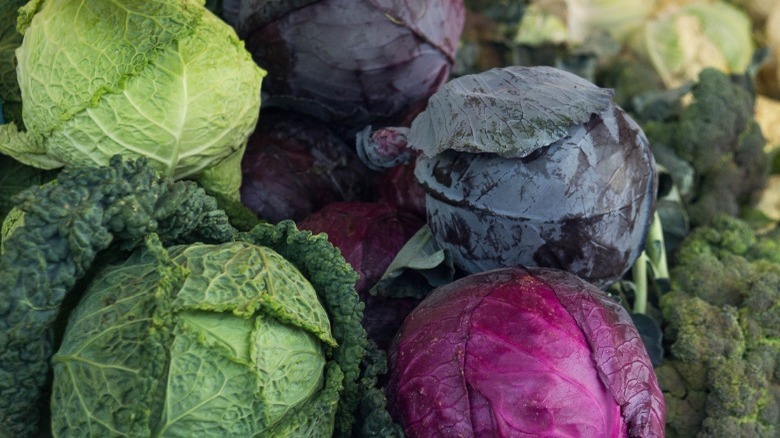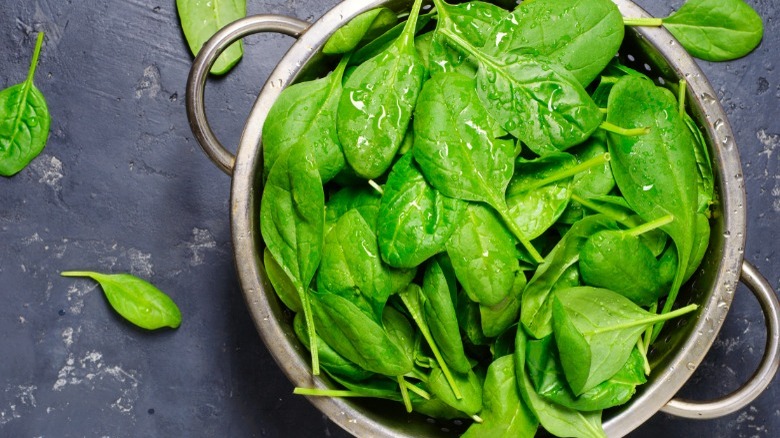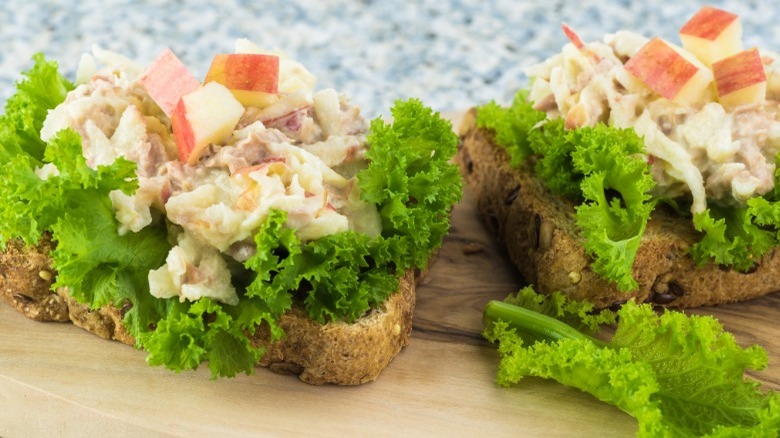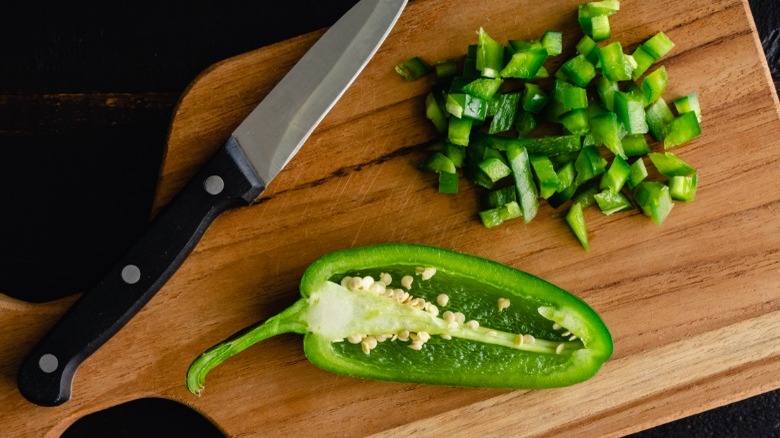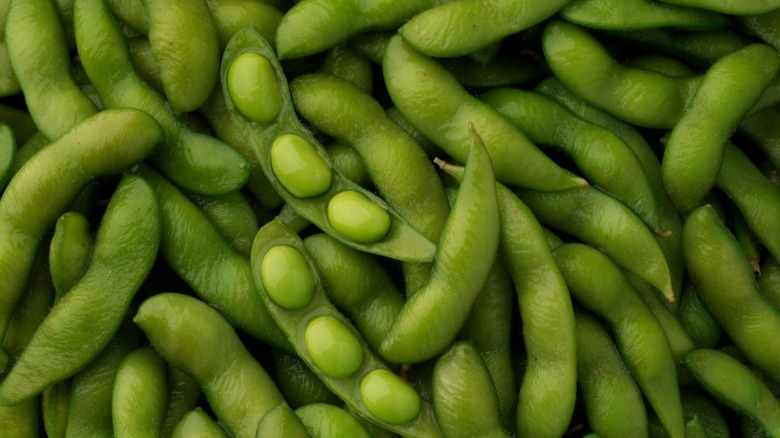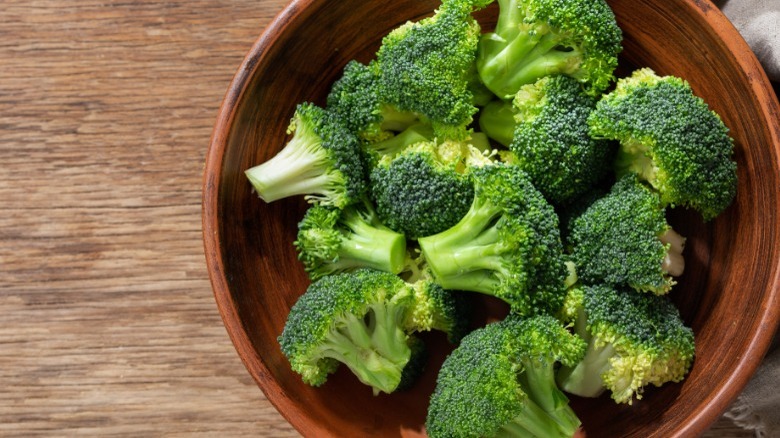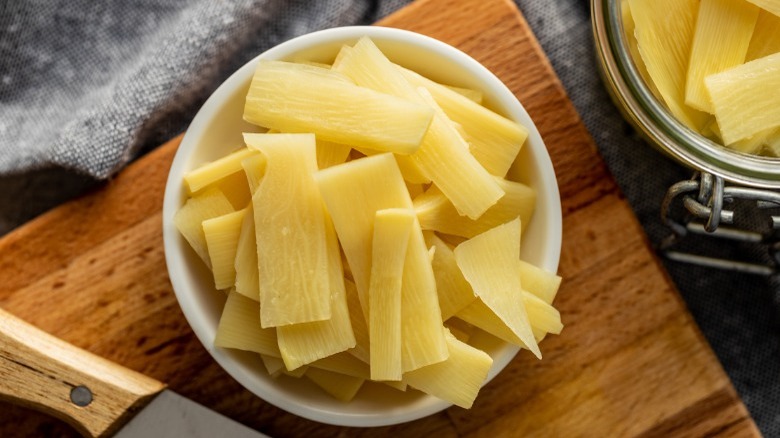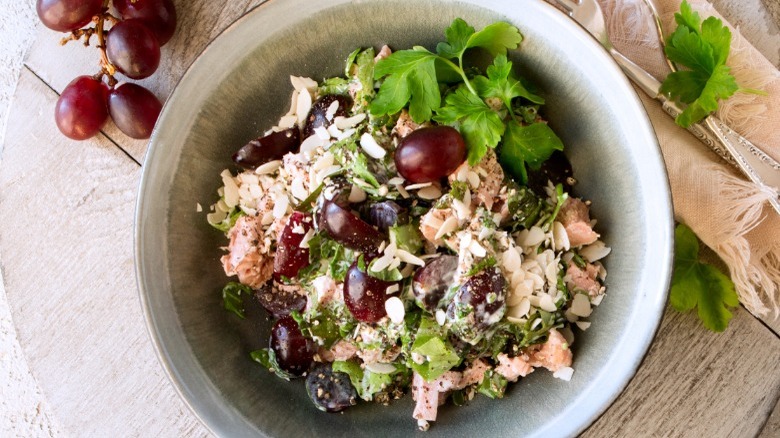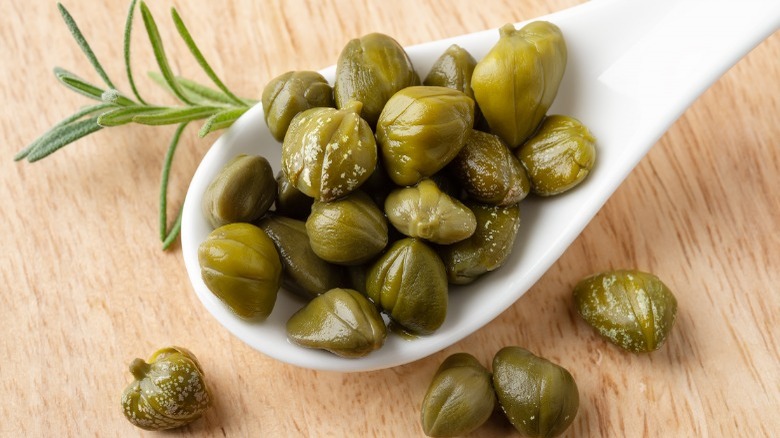15 Ingredients You Can Use To Replace Celery In Tuna Salad
Classic tuna salad is a light and tasty comfort food packed with satisfying textures and flavors that many people love. It's also fast and easy to prepare, making it ideal for a meal on the go or a quick lunch favorite for the family. While traditional tuna salad is usually made with celery for a crunch that complements the richness of the tuna and the creamy mayo, not everybody is a fan of its signature bold and bitter taste.
According to a survey published in Japan Today, celery tops the list of vegetables that adults dislike, with about 36% of participants claiming to hate its potent flavor. However, this doesn't mean your tuna salad has to fall flat because you'd rather skip the celery. There are several foods that you can swap out for celery that will make your tuna salad just as crisp and maybe even more delicious.
If you're looking for something to replace celery in your tuna salad, here are some alternatives that will have you wondering how you ever ate this classic dish without them.
Cucumbers
A diced cucumber is an excellent addition to tuna salad and a perfect alternative to celery. Not only does cucumber add a pop of color to the dish, but it also provides a good crunch that people might miss when celery isn't included in the mix. However, unlike celery, cucumbers have a mild, sweet taste that enhances other flavors rather than overpowering them. They also have a cool crispness that can give your tuna salad a refreshing bite.
In addition to their taste, cucumbers are a good source of several vital nutrients and antioxidants, including flavonoids, vitamin K, vitamin C, potassium, and fiber. They also have a particularly high water content, helping boost hydration and digestive health.
When making tuna salad with cucumbers, leave them unpeeled to maintain their texture and get the most nutritional value from the skin. Also, choose a firm, ripe cucumber for your tuna salad, as this will help you avoid excess liquid or a mushy consistency that tends to happen when cucumbers become overripe. About half a cup of diced cucumber is a good amount to mix with two cans of tuna fish, along with the other ingredients you add to your tuna salad. Check out this creative tuna salad recipe for a cucumber-forward take on the classic.
Olives
If you love Mediterranean flavors, olives might be the ideal tuna salad ingredient to replace celery. Olives are a flavor-packed fruit that elevates any dish with a uniquely savory saltiness in every bite. As a staple of Mediterranean diets, you'll often find them used for cooking, as a way to enhance flavors of other foods, or as a delicious snack on their own.
Depending on which type of olive you choose, you can use them to add a punch of salty sweetness, subtle nuttiness, or distinctive tanginess to your tuna salad. However, it's a good idea to start on the mild side, especially if you're preparing tuna salad for guests or a party. Not only can briny olives be an acquired taste, but some of them are quite bitter and can be potentially overpowering.
For a mouthwatering Mediterranean tuna salad, go for sliced Kalamata or Greek black olives. They tend to have a more fruity flavor and rich bite that pairs well with the tuna. While you're at it, try adding some Mediterranean herbs to make those olives sing, like fresh basil, oregano, and parsley. Toss in some red onions and artichoke hearts, and you've got yourself a tuna salad recipe that everyone is sure to remember.
Carrots
Carrots are a simple and satisfying way to add a good crunch to any dish. Tossing them into a tuna salad is no exception. Whether eaten raw or cooked, carrots also offer an earthy sweetness, which makes them an ideal ingredient for those wanting to get away from the bitterness of celery in their tuna salad.
If you're not sure how to incorporate carrots into your favorite tuna salad recipe, the good news is that carrots are incredibly versatile, giving you some flexibility to experiment and see what works best for your taste. For instance, shredded carrots have a unique texture that will be very different from chopped or diced carrots. You may also choose to season and slightly cook your carrots before adding them to the tuna mix, which is another way to bring in new flavors and put a twist on a classic. Just be sure to peel your carrots first to avoid a gritty or grainy texture.
Bell peppers
With a satisfying crunch and an impressive depth of flavor, bell peppers can take your tuna salad far beyond what celery ever could. For the most crunch, finely chop your bell pepper, add it to the tuna and other ingredients, and mix it well before serving.
However, you can also cook the bell peppers to bring out some of their sweet and earthy notes. For example, throwing your peppers on the grill will give you a smokey char on the skin and a more tender bite. It will also draw out some of the moisture from the pepper, which can keep your tuna salad from becoming a little slimy. You can also do a quick saute with garlic to add more flavor to the bell peppers before tossing them into your tuna salad.
You should also think about the type of bell pepper you want to use to get the right flavor. Green peppers are the least ripe, which makes them more bitter and earthy than yellow, orange, or red peppers. Yellow and orange bell peppers are sweeter and more fruity than green ones without being overpowering. Red bell peppers are the sweetest and also contain the most nutrients of all (per WebMD).
Radish
When you think of root vegetables, the ones that typically come to mind are probably carrots, potatoes, and onions. However, there is another flavorful root that doesn't get as much of the limelight, though it should. The radish is a refreshingly zesty and colorful vegetable that can vary in taste, ranging from mild and zingy to peppery and spicy.
While you may have seen this bright cruciferous vegetable in your produce aisle or as a garnish on a dish, you may not know just how flavorful and nutritious it can be. Radishes are absolutely packed with antioxidants, vitamin C, fiber, and beneficial chemical compounds that can help boost your health (via WebMD). If that's not a good enough reason to toss them into your tuna salad, they will add a punch of heat and onion-like zest that is anything but boring.
You can certainly eat radishes raw, which will maintain their peppery taste. Simply dice them up and add them to your tuna salad if you prefer to eat them this way. However, you can also roast, braise, or pickle your radishes, which can give your tuna salad more of a sweet or tangy layer of flavor.
Green onions
For those who love to cook, you already know that green onions are a kitchen staple. From the tips of their long green stalks to the bottom of their small white bulbs, these alliums offer an array of versatile flavors that are crucial when putting a tasty dish together in a pinch. Because green onions are simply onions that have been harvested before they reach maturity, they provide the same rich and aromatic flavors as their adult counterparts — although more mild and subtle.
To add crisp texture and a rounded hint of spice to your tuna salad, it's time to start chopping. First, use some of the soft tops of the green onion for more crisp and fresh flavors. Then, add part of the white bulb for a sweet and pungent touch that is a good stand-in for onion and garlic. Don't forget to taste as you go to avoid throwing too much into the mix. You want to achieve a good balance between the green onion's crunch and the other creamy ingredients in your tuna salad.
Cabbage
Cabbage is so much more than those hard, throw-away green bits you find in pre-bagged salad mixes. While this leafy vegetable does have a reputation for bitterness, several types of cabbage offer different kinds of flavors that can really boost your tuna salad. All this is in addition to the cabbage's powerhouse crunch that can easily rival celery.
While green cabbage is the most common variety available, there's also red cabbage, savoy or "curly" cabbage, Napa cabbage, and so many more. In fact, bok choy, a leafy vegetable used in many Asian dishes, is also a type of cabbage that can provide a bright yet mildly sweet taste to your tuna salad.
The trick to adding cabbage to tuna salad is to chop it finely before mixing it in. Because cabbage is such a sturdy vegetable, you run the risk of making tuna an afterthought if you don't dial down cabbage's texture. Next, add the chopped cabbage sparingly, just as you would with celery, to keep it from overpowering the other ingredients. Lastly, use a high-quality mayonnaise with a good squeeze of lemon to fully coat and slightly wilt the cabbage, giving you perfect texture and flavor.
Spinach
Readily available and generally inexpensive, spinach is another great substitute for celery in any tuna salad recipe. Freshly chopped spinach is full of color, flavor, and beneficial nutrients that will upgrade your tuna salad to a full-blown superfood meal that the whole family will love.
To get the most crunch from your spinach, choose fresh, sturdy greens that haven't begun to wilt. You should inspect the leaves to ensure they are dark green and crisp, which means the spinach will hold up a little better to the other ingredients in your tuna salad without falling flat. Also, because spinach can quickly turn slimy if you don't use it right away, timing is important here. Add it as close to serving time as you can.
While flat-leaf spinach is the most popular type of this green and is often available pre-washed and packaged for immediate use, you may want to consider other varieties. Curly-leaf spinach is especially useful if you're trying to recreate the crunch of celery. Just know that curly-leaf spinach leans more on the bitter side and has a consistency that's closer to kale than more tender baby spinach.
Apple
If bitter or spicy isn't your thing, adding crisp apples to tuna salad gives it an uplifting sweet and sour combination that's just what your taste buds crave. However, some apples have a hard bite or mealy consistency, which can create an unpleasant texture if you're not careful. This is why it's essential to choose the right type of apple and balance all your ingredients thoughtfully.
Gala apples work best for tuna salad because of their sweet, floral flavors and dense yet soft bite. Fuji or McIntosh apples are also excellent alternatives if you don't have Gala apples on hand. While Fuji apples are crisp and firm with sweet, citrusy notes, McIntosh apples are tangy and tender. No matter your preference, there's definitely no shortage of apple types to make your tuna salad recipe exactly the way you want.
Before adding the apple to your tuna salad mixture, take a minute to core and dice it. Keep in mind that one apple goes a long way in tuna salad. You most likely won't need more than one apple. Even then, you might not use the whole thing, depending on how much salad you're making. Also, apples pair well with lemon and fresh herbs like basil or mint, which can help further elevate your tuna salad as well.
Jalapeño
Just because traditional tuna salad isn't spicy doesn't mean you can't add some heat to your recipe. Not only are crunchy sliced jalapeño peppers an excellent option to replace celery, but they also add a bright spiciness to your tuna salad without dialing up the hotness too much.
According to PepperScale, jalapeños are actually in the mild to moderate range of spiciness compared to other peppers, hitting 2,500 to 8,000 on the Scoville scale. However, that doesn't mean they can't bring the heat. A small chopped jalapeño in your tuna salad can be enough to have you reaching for a cold drink after a few bites.
If you're ready to give this hot tip a try, try using one jalapeño pepper to two cans of drained tuna fish to get the right balance of heat. Consider bringing in cilantro, lime juice, and sweet onion to round out the south-of-the-border flavors. This tuna salad recipe is perfect for a party or as a lunch appetizer with corn chips.
Edamame
Edamame is soybean that has been harvested early to maintain a more tender texture than fully mature soybeans. With bright green color and mildly nutty flavor, edamame is usually eaten as a snack right out of its shell or in cooked dishes.
Originating in east Asia, edamame has become popular in western countries more recently. This rise in demand means you can get them at just about any grocery store, typically already prepped and ready to eat. If you can find a package of steamed and shelled edamame, it will definitely save you the time and energy of having to pop the beans out of their pods on your own!
Once you've got your edamame, use about ¼ cup for every can of tuna fish you include in your recipe. This keeps the proportions balanced without overshadowing the tuna. You should also think about adding other Asian ingredients to your tuna salad, such as a dash of soy sauce or a dollop of wasabi, to help round out the flavors.
Broccoli
For people who love broccoli salad, adding broccoli to tuna salad is an obvious and excellent way to capture those flavors in a different dish. Broccoli can give tuna salad a pleasant crunch, rich flavor, and a punch of vitamins, minerals, fiber, and health-boosting chemical compounds (via Healthline). You'll also get a vibrant pop of color that adds a beautiful visual element that you might miss when you skip the celery.
While you can just chop up some raw broccoli and add it to your tuna salad, you may want to take your technique a step further to craft a truly unique dish. Try tossing some broccoli florets into your food processor for a few pulses to create a veggie mix with rice-like consistency. Then, combine your broccoli pieces with your tuna and other ingredients. This way, you'll get a satisfying taste of broccoli in every bite without large or awkward chunks. You can also add fresh herbs, onion, and lemon juice to taste.
Bamboo shoots
If you really want to try something different when looking for a good celery substitute for your tuna salad, consider bamboo shoots. However, you'll likely add some prep and cooking time to your otherwise simple recipe. Bamboo shoots, which are the tender sprouts of the bamboo plant, typically need to be cooked to remove any potentially harmful toxins (via Healthline). If you choose to go with fresh bamboo shoots, you must boil or soak them in water before incorporating them into your tuna salad.
On the upside, bamboo shoots deliver a sweet and earthy flavor and a crisp yet tender texture that's perfect for ramping up a tuna salad. Even if you don't have fresh bamboo shoots available in your produce section or local farmers' market, you should still be able to find a canned version that is almost as good. Simply drain and chop the canned shoots into long, thin slices. Next, mix them into your tuna salad to get a celery-like texture.
Grapes
Chilled grapes in your tuna salad are a cool and refreshing way to put a new twist on an old classic. Grapes add a layer of sweet and tangy flavor that tends to pair well with the bold and savory taste of tuna. On top of that, grapes also have a great snap and delicious bite that provide the texture you want when you nix the celery in a tuna salad.
When it comes to tuna salad, your best bet is to go for red seedless grapes that are fresh and plump. While you can use green grapes, they tend to be sourer, which may not be palatable to some people. Of course, you also don't want to use grapes that have started to shrivel or go mushy.
To use this fruit, simply cut your grapes in half and add them to your tuna mixture. Some things that pair well with grapes in tuna salad are red onions, walnuts, tarragon, and lemon juice. Also, don't be afraid to go all-in with your seasoning. Although grapes may seem delicate, they can hold up to some strong flavors, so now it's the time to be bold.
Capers
If you find that your tuna salad is a bit bland without celery, you may be wondering what seasonings you should be using to make things more interesting. Luckily, there's a quick and easy answer to your flavoring woes: capers. Adding these edible flower buds, which are typically brined or packed in salt, to your recipe can boost any tuna salad that seems to be falling flat. Pickled capers might be small, but they are bursting with briny, tangy, and citrusy notes that go particularly well with fish and other types of seafood.
Jarred capers are typically easy to find in grocery stores and can be stored for a long while without going bad. This is especially good news because you don't need many of these to punch up the flavor of your tuna salad. Because capers can be intense, go slow and taste often when adding them to your recipe. Mix in a few at a time and sample as you go to make sure you're getting the perfect balance of flavors.
